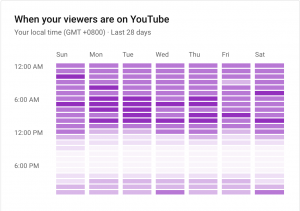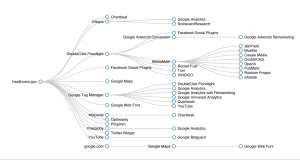
For most businesses, the website is the primary driver of inbound leads. There is often a direct correlation between the quality of a lead and how much time they have spent on your website. Because of this, marketers are constantly working to increase the time visitors are spending navigating their site. Using most analytics tools, marketers can report accurately on key metrics, all of which represent engagement. Measuring pageviews, CTA clicks and form submissions will help to show how well your website is performing overall. The more time a visitor spends on site, the more likely they are to consume your content, research your solutions, and ultimately convert into a lead. Here we will give you 11 ways to keep visitors on your site even longer.
1. Multimedia
One very popular way to increase the time that visitors are spending on your site is to add multimedia to your webpages, especially your homepage. Videos have been shown to increase user engagement and can be a great way to showcase your products or solutions. There are many ways to do this. Some modern sites are using a full-width video as the background of the homepage while others have an embedded video player at the top of the page. However you choose to incorporate video, it can certainly help to engage visitors from the start.
2. Clear Value Proposition
Bounce rate is another metric that most marketers look at each month. A common reason why visitors tend to bounce, especially when coming from an organic search, is that they do not feel like they belong, or that your site can provide enough value. To minimize this, be sure to have a clear value proposition on your homepage. When first-time visitors land on your site, it is important that they can tell exactly what you do and who it helps. This will ensure that your personas do not leave your site immediately.
3. Improve Website Load Time
In addition to a lack of value proposition, many visitors immediately bounce from a website when it takes longer than normal to load. Keep in mind, when visiting a site from organic search, the visitor is presented with 9 other options, not including ads. If a website is not loading quickly, most visitors will hit the back button and try another site. To prevent this from happening, make sure that your website is hosted on a modern CMS, and if you have any plugins that take time to load or are slowing your site down, remove or replace them with faster, more lightweight tools.
4. Clear Navigation and User Experience
Another great way to keep visitors on your site longer is to have a clear, simple navigation as well as an intuitive user experience. In many cases, navigation menus on websites have too many links, drop-downs, and options, which can lead to visitors feeling lost. Be sure to simplify your main navigation, highlighting the key website pages you want visitors to read. Another piece to consider here is mobile responsiveness. Around half of website traffic comes from mobile browsers and if your site is not responsive, you will most likely see a significant increase in bounce rate.
5. Internal Links
To piggyback off the previous point, you can prioritize key website pages through internal links within content. This can be done on both blog posts as well as key website pages, where you want to provide the reader more information on a certain topic. Internal links significantly increase pageviews and will drive visitors deeper into the website. When doing so, be sure to use compelling, keyword-rich anchor text to show the topic of the next page but also provide SEO value.
6. Avoid Long Blocks of Text
Just like when reading the newspaper or a book, it is difficult to keep one’s attention when reading a long block of text. This is especially the case on webpages, both for desktop and mobile viewers. Utilize whitespace and small paragraphs on text-heavy pages, with concise information and takeaways. A main driver of visitors leaving a website is that the text or pages themselves were not engaging. Be sure to avoid long blocks of text both on interior pages and blogs, focusing more on the quality rather than quantity.
7. Search Functionality
Adding a search bar to your website can greatly improve user experience as well as the length of sessions visitors spend on your site. In many cases, visitors come to your site with a question in mind. This could be more industry related or research on your solutions. By giving visitors the ability to search your content, they can easily find the information most important to them. This will eliminate the need to navigate your website’s menu and give them the answers they are looking for right away.
8. Up-to-Date, Timely Content
An often overlooked key to keeping visitors on one’s site longer is the timeliness and currency of content. When reading a blog, if the posts have not been updated in quite a while, or the content is outdated, visitors tend to not attribute much value. As a content marketer, it is important to keep your blogs frequent and current. Try to pull from current events or talk about new industry trends; all of which will show that your website is full of useful information.
9. Enticing CTAs
As mentioned before, the ultimate goal for website visitors is conversion. It’s important to drive relevant traffic to your site that is qualified to convert through content downloads and sales-related offers. To accomplish this, add enticing CTAs to key website pages and blog posts. Be sure to align the content based on personas as to be most relevant and yield the highest click-through rate possible. These offers will undoubtedly keep visitors engaged and on the site longer, ultimately converting them as a lead.
10. Related Articles on Blog Posts
Blogs are a great way to engage visitors on your site with relevant content. To maximize this benefit, it can be helpful to offer related blogs on a similar topic at the end of the article. Many content management systems have a module that will provide a handful of additional blogs within the same category, which you can place at the bottom of a blog post. This will keep visitors engaged while improving your thought-leadership and expertise on a particular subject.
11. Blog Subscription
Keeping with the blog theme, be sure to have a subscription form available for visitors who want to receive your blog content by email. Although this may not improve the length of sessions on the site initially, it will drive repeat traffic and further engagement over time. By keeping up with blog publishing, you can reach your subscribers weekly, encouraging them to revisit your site and increasing the likelihood that they will convert into a qualified lead.
The more engaging your website is, the longer visitors will stay. This is the central theme of optimization for user experience and website behavior. Above we’ve listed 11 steps you can take to keep visitors on your site even longer. By doing so, you can expect an increase in visit-to-lead conversion and high quality of new contacts. What other methods have found to be successful for keeping visitors engaged?
Digital & Social Articles on Business 2 Community
(77)
Report Post







